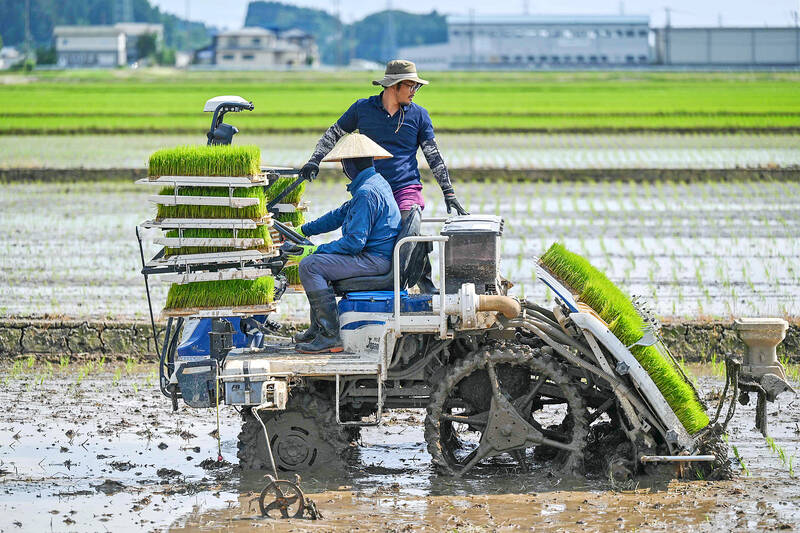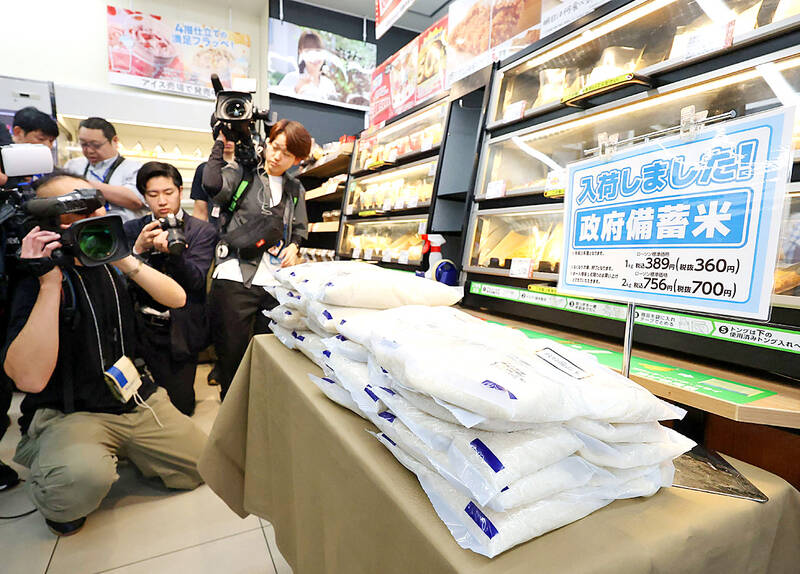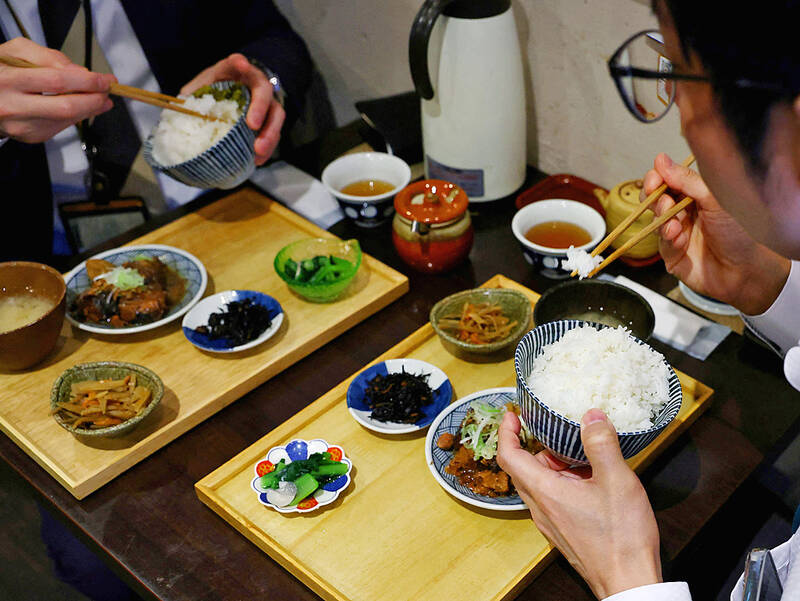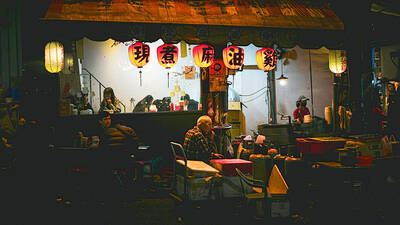Rice is essential to Japanese culture, tradition and politics. People take pride in the oval-shaped sticky Japonica grain, which is still a staple even though total consumption has fallen over the decades.
But since last summer, prices have soared as supplies have fallen short of demand. The government has long paid farmers to cut back on rice acreage, and change to other crops to keep rice prices relatively high.
To cope with shortfalls this year, the government has released rice reserves. But the grain has been slow to reach supermarket shelves. Anger over that was part of the reason the Agriculture Minister Taku Eto quit last month, after he raised an uproar by saying he “never had to buy rice,” because his supporters give it to him as gifts.

Photo: AFP 照片:法新社
The remark was seen as utterly out of touch with the realities of ordinary people struggling to make ends meet and to afford rice to eat. Eto apologized, but he was obliged to step down as damage control by Prime Minister Shigeru Ishiba, whose minority government faces a big challenge in a crucial national election in July.
Eto’s successor is former environment minister Shinjiro Koizumi, who has taken part in reforming Japan’s powerful agriculture lobby. He’s been tasked with investigating and resolving the rice problem.
Rice started disappearing from supermarket shelves, and prices surged to twice normal levels since last summer, when a warning about a possible “megaquake” triggered panic buying.

Photo: AFP 照片:法新社
The top “Koshihikari” brand now sells for nearly 5,000 yen ($35) per 5 kilograms. Rice stocks at Japan Agricultural Cooperatives and other commercial wholesalers have been 400,000 tons short of last year’s levels, hitting a record low 1.53 million tons as of June, farm ministry data show.
The sense of urgency over shortages has risen now that rice crops have just been planted, with harvests several months away.
Ishiba acknowledged current measures aren’t working and blamed “structural problems” of the government’s rice policy.

Photo: Reuters 照片:路透
Experts say last summer’s panic buying just worsened longstanding problems. A sharp rise in tourism and an increase in dining out have raised demand.
Some people started eating more rice after prices of bread and noodles rose when the Russia-Ukraine war pushed wheat prices higher. And the 2023 harvest was relatively poor because of hot weather and pests.
Japan’s rice supply chain is complicated. Most farmers still sell their rice in the traditional system run by Japan Agricultural Cooperatives, or JA, a powerful interest group with close ties to the governing Liberal Democratic Party.
But a growing share is sold through other businesses and online, making it hard to track supplies and prices, said Masayuki Kanamori, an executive of the National Federation of Agricultural Co-operative Associations, a JA umbrella organization.
The shortage caught JA by surprise, Kanamori said.
“Looking back, the current rice shortage was unforeseeable,” he said. “We are puzzled.”
The Agriculture Ministry is under fire for delaying releases of emergency rice reserves, which normally are kept for disasters, and for misjudging the demand-supply balance. So far, only 10 percent of the released rice stocks have reached the market, raising suspicions about what’s happening.
One problem may be a lack of enough milling capacity to turn the stocks of brown rice kept in reserves into the pure white rice that Japanese prefer. But others have accused some wholesalers of hoarding rice to keep prices higher.
Ultimately, Japan will need to figure out a long-term strategy since the average age of its farmers is 69, and the farming population has fallen by half over the past two decades to 1.1 million in 2024.
Whatever the cause of the shortages, retailers must put rice on the shelves, so some are switching to imports, which usually aren’t popular with finnicky Japanese shoppers.
(AP)
米在日本的文化、傳統和政治中都至關重要。人們以這種橢圓形、有黏性的日本品種稻米為傲,儘管數十年來總消費量一直在下降,但米仍然是日本的主食。
但自去年夏天以來,由於供不應求,米價飆升。政府長期以來提供農民補貼,鼓勵他們減少水稻種植面積,並改種其他作物,以保持米價在相對高位。
為了因應今年的短缺,政府釋出了儲備米,但這些米遲遲未能在超市上架,引發眾怒。日本農林水產大臣江藤拓上月辭職,部分即肇因於此。他曾表示自己「從來不用買米」,因為他的支持者會把米當禮物送給他,此言一出,引發軒然大波。
這番言論被認為不知民間疾苦,對老百姓為生存奔波、買不起米而苦苦掙扎的窘境渾然不覺。江藤為此道了歉,但首相石破茂為了止血,江藤被迫下台。石破茂領導的少數政府在至關重要的7月全國大選面臨巨大挑戰。
江藤的繼任者是前環境大臣小泉進次郎,他參與了日本強大的農業遊說團體的改革。他受命調查並解決米荒問題。
自從去年夏天日本「超大地震」預言開始流傳後,引發了恐慌性搶購,超市貨架上的米開始缺貨,價格飆升至平常的兩倍。
目前,頂級品種越光米的售價接近每5公斤5,000日圓(35美元)。農林水產省的數據顯示,截至6月,日本農業協同組合和其他批發商的米庫存已比去年同期減少40萬噸,達到153萬噸的歷史新低。
現在稻米才剛播種,還要等幾個月才能收穫,短缺的緊迫感日益加劇。
石破茂承認,目前的措施並未奏效,並將問題歸咎於政府稻米政策的「結構性問題」。
專家表示,去年夏天的恐慌搶購只會讓長期存在的問題雪上加霜。旅遊業的急劇成長和外食的增加也推高了需求。
俄烏戰爭推高小麥價格,導致麵包和麵條價格上漲後,有些人開始吃比較多的米。此外由於天氣炎熱及蟲害,2023年的收成相對較差。
日本的稻米供應鏈錯綜複雜。大多數農民仍是透過日本農業協同組合(JA)營運的傳統系統銷售稻米。JA是一個與執政的自民黨關係密切的強大利益團體。
但JA的傘狀關係組織——全國農業協同組合聯合會執行官金森正幸表示,越來越多的米是透過其他企業和上網銷售,這使得追蹤供應與價格變得困難。
金森表示,此次稻米短缺令JA措手不及。
「回想起來,當前的稻米短缺是無法預見的」,他說。「我們百思不解」。
農林水產省因太晚釋出儲備米以及誤判供需平衡而受到批評。儲備米通常用於災害等緊急情況。目前只有10%的儲備米進入市場,這引發了質疑。
缺乏足夠的碾米能力也可能是個原因,儲備的糙米必須經過加工,才能成為日本人喜歡的白米。但也有人指控某些批發商囤積米以抬高價格。
日本最終需要制訂長期的策略,因為日本農民的平均年齡為69歲,農業人口在過去的20年下降了一半,2024年的數據為110萬人。
無論是什麼原因造成稻米短缺,零售商的貨架上都必須有米可賣,因此一些零售商正轉向進口米,但挑剔的日本消費者通常不喜歡進口米。
(台北時報林俐凱編譯)

★ Bilingual Story is a fictionalized account. 雙語故事部分內容純屬虛構。 “Any New Year’s resolutions?” he asked. Lena put her coffee down. “Yeah,” she said. “To get in shape.... round is a shape, right?” Mark chuckled. “I support this. Fully achievable. Low risk.” “Thanks,” she smiled and lovingly rubbed her round belly. “I like a resolution I can’t fail.” “Funny thing is, I was thinking about getting round too.” Lena nodded her head in approval, “You could put some meat on those skinny bones of yours.” Mark shook his head, “Not that kind of round. Wheel-of-Life round.” She raised an eyebrow.

詞法—不定詞的誤用 1. 我得記住星期五要把報告寫好。 ˇ I must remember to finish my report by Friday. χ I must remember finishing my report by Friday. 註︰remember 後面跟動名詞或不定詞表示兩種不同的概念,與 forget 相類似。 試比較下列句子: I remember meeting him somewhere.(我記得曾經在某處見過他。) I must remember to meet him at the station at six this evening. (我必須記住今晚六點得去車站接他。) He remembered turning off the light when he left the room. (他記得離開房間時曾先把燈熄了。) Remember to turn off the light when you leave the room. (記住離開房間時要把燈關了。) 2. 他提醒她做好她份內的事。 ˇ He reminded her to do her job. χ He reminded her of doing her job. 註︰remind ... of ... 後面跟動名詞,表示「使人想起做過某事」。若是「提醒某人應做某事」,應用 remind ... to do ...。試比較下列句子: He reminded me of my attending the lecture last Friday. (他讓我想起我上星期五去聽過那次演講。) He

Skating is a popular recreational and competitive activity that involves sliding over surfaces using specially designed footwear. Its origins date back over 1,000 years to Northern Europe, where people first strapped animal bones to their feet to move across frozen lakes and rivers. In the 17th century, the Dutch transformed skating into a leisure activity. They also replaced bone blades with metal, leading to the creation of modern ice skates. Today, ice skating is enjoyed as a global sport and an exciting pastime by people of all ages. Figure skating is one of the best-known and most graceful forms of skating.

對話 Dialogue 清清:最近天氣越來越冷,感覺很容易感冒,要不要一起去吃薑母鴨或是羊肉爐? Qīngqing: Zuìjìn tiānqì yuèláiyuè lěng, gǎnjué hěn róngyì gǎnmào, yào bú yào yìqǐ qù chī jiāngmǔyā huòshì yángròulú? 華華:最近我覺得有點累,想吃薑母鴨,可是又怕一下子吃太補會上火。 Huáhua: Zuìjìn wǒ juéde yǒudiǎn lèi, xiǎng chī jiāngmǔyā, kěshì yòu pà yíxiàzi chī tài bǔ huì shànghuǒ. 清清:那我們去喝香菇雞湯吧,不太容易上火,喝了也會很暖和。 Qīngqing: Nà wǒmen qù hē xiānggū jītāng ba, bú tài róngyì shànghuǒ, hē le yě huì hěn nuǎnhuo. 華華:聽起來不錯!你們家平常冬天都吃什麼進補? Huáhua: Tīng qǐlái búcuò! Nǐmen jiā píngcháng dōngtiān dōu chī shénme jìnbǔ? 清清:我家都煮麻油雞,吃完整個人手腳都會熱起來。我也很久沒喝香菇雞湯了,正好可以去打打牙祭。 Qīngqing: Wǒ jiā dōu zhǔ máyóujī, chī wán zhěnggè rén shǒujiǎo dōu huì rè qǐlái. Wǒ yě hěn jiǔ méi hē xiānggū jītāng le, zhènghǎo kěyǐ qù dǎ dǎ yájì. 華華:可是我最近在減肥,會不會吃得太補,肉又長回來了? Huáhua: Kěshì wǒ zuìjìn zài jiǎnféi, huì bú